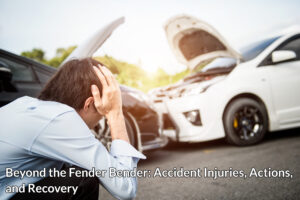The Association for Safe International Road Travel states that 2.35 million Americans are injured or disabled in a road crash each year. The chance of being involved in a car accident it typically 3-4x for every individual throughout their driving lifetime. It?s not a matter of ?if? but ?when?. Here is what you should know about car accident injuries, what to do if you experience one, and the long-term recovery options available.
The Common Car Accident Injuries
The common injuries are found in two areas:
- Behind the wheel
- As a pedestrian
We?re deathly afraid of accidents when we?re behind the wheel because of the carnage that can happen due to the speed and weight of the vehicles. Yet, you?re just as much at risk of an accident when out for a walk, passing through a parking lot, or crossing the road. Here?s a sample of how it looks by the numbers:
- Struck by car: 74,000+
- Injury involving closing a door: 150,000+
- Injury involving using a jack: 100,000+
- Back-over and single car crashes: 841,000+
These types of injuries may include head & back, neck & chest, and other appendages. Car-related injuries are also quite common and often lead to the larger accidents. A simple accident such as falling in (or out) of the vehicle could spell serious damages or fatality. The point being: don?t always expect an accident to occur on the road.
The Post-Accident Actions to Take
As far as what to do after the car accident?

- Lawyer Up. Get in touch with local personal injury lawyers that will help recover losses and provide guidance for claiming property & bodily injury claims. Vet their experience based on their legacy and success rates. Don?t pay up-front! Good law firms will offer a free consultation and often work on a ?contingency fee? basis whereas they only get paid when you win.
- Visit the Hospital. Accidents may cause life-threatening complications even if you do not show external damage. It?s important to visit the hospital to get a full checkup for any internal damage to bodily organs, bones, and the brain.
Doing on (or all) of these will give peace of mind. Yet, there?s more to be done?
The Long-term Recovery Options & Resources
Accident recovery times vary in length based on severity. Long-term recovery options present a struggle and challenge to one?s willpower but ultimately brings the individual back to normalcy. Here are the options (and resource) available for long-term recovery:
- Psychological Therapy. Accidents are a traumatic experience which may have caused brain damage or cause long-term anxiety and phobias of the road. Therapy will help ease the nervousness and stress related to driving through anxiety management, medications, and stress-relieving exercises.
- Physical Therapy. You will likely start a routine of physical therapy after you?ve healed which involves the slow progression of regaining motor abilities. This therapy is often accompanied by a professional or done at home from suggestions and guidance of your medical professional.
- Pace Yourself. The best remedy to injury is proper rest. This means the full amount of time lounging around and taking prescriptions. Listen to your doctor!
Commit (or help others) with the recovery one day at a time.
Conclusion
No one wants to experience injury because of a car crash but it?s bound to happen on a long enough timeline. Our best option is to slow down and be a defensive driver to reduce our risks; keep 100% of your attention on the road, practice safety, and plan the next actions if you experience an event.